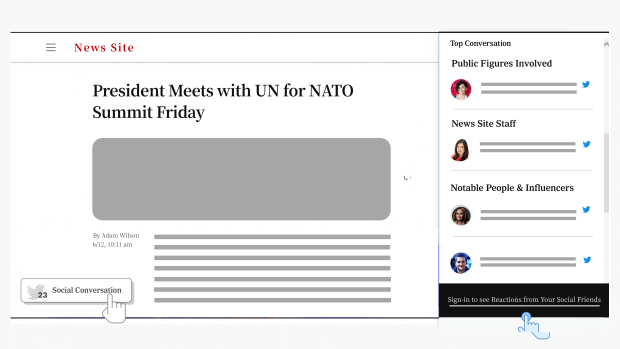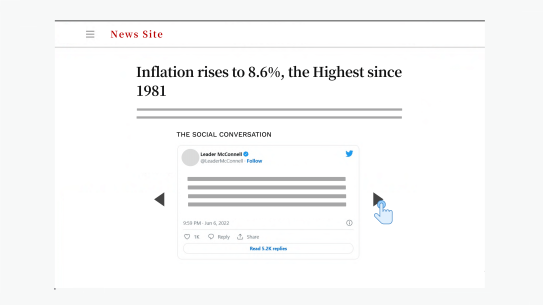AI & Local News Challenge, Social Fabric

Mock up of news website page with features from Social Fabric. Headline text says “President Meets with UN for NATO Summit Friday.” A button in the lower left corner has the twitter bird icon with the number 23 superimposed over it and reads "Social Conversation." A sidebar on the right side of the page has summary blocks that reads “Top Conversation: Public Figures Involved; News Site Staff; Notable People & Influencers.” At the bottom of the block it says "Sign-in to see Reactions from Your Social Friends"
RESEARCH & INNOVATION | CENTERS | NYC MEDIA LAB | PROJECTS | AI & LOCAL NEWS
Social media has become the de facto town square for the world’s influencers, newsmakers, and citizens to share perspectives on the events of the day. Social Fabric curates that influential, relevant social conversation so it can be presented adjacent to news articles pages for readers to be able to consume alongside the story. This adds the additional context of views from thought-leaders and peers — which readers desire — to more deeply understand the news and its impact on them.
Built over years with many millions of data points and extensive R&D, Social Fabric’s new, unique technology for the marketplace now makes it scalable to include this topical conversation across the 1000s of daily stories in the news cycle—offering a modern way to present content by publishers alongside the conversation it sparks.
Additionally, Social Fabric’s technology can be used to help drive personalization features, tapping into readers’ connected social graphs. News environments can become stickier and more engaging through perspectives and story recommendations from a reader’s social friends as well as better content targeting around their interests.
Throughout our time with NYC Media Lab, it has afforded us the opportunity to connect with other companies, organizations, newsroom leaders, and startup founders who are innovating in the technology and news/content space. The ability to engage with this specialized and dynamic ecosystem only further motivated everyone’s dedication and energy into creating next-generation A.I.- and data-driven products.
With the leading amount of digital time spent on social platforms by internet users, we see current audiences care not just about reading the news but being able to view it through the lens of thought-leaders they appreciate and trusted friends and peers who they feel are similarly impacted by the issue. Readers look to these voices as “guides” to help them make sense of events, often relying on social platforms as a result.
Our technology recognizes that consumers no longer just want one singular voice to help them understand how a story may affect them, and makes it easy to present other viewpoints—often culturally significant or influential—in these environments.
The technology can be configured and leveraged in numerous ways and presented with a native-style feel, organic to the environments they are integrating into. Below is an example of a possible UI integration in a news environment:




